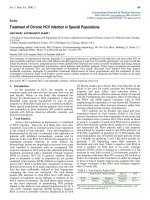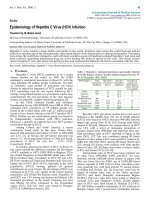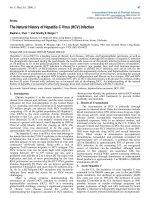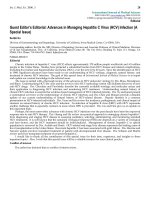INVASIVE FUNGAL INFECTION
Bạn đang xem bản rút gọn của tài liệu. Xem và tải ngay bản đầy đủ của tài liệu tại đây (293.76 KB, 15 trang )
INVASIVE FUNGAL INFECTION
BUI THI VAN NGA
Microbiology depaterment
Invasive fungal infection
Invasive fungal infection are a significant cause of morbidity and mortality
worldwide.
Candida species are the most common fungal pathogens encountered.
The term invasive candidiasis: candidemia, endocarditis, meningitis and
other forms of deep organ involvement.
Fungal species
Candida species: C.albicans, C.tropicalis, C.krusei, C.glabrata….
Aspergillus.
Cryptococcus.spp
Fusarium.spp.
Zygomycetes
(mucormycose).
Risk factors for invasive candidiasis
Candida colonization
Broad- spectrum antimicrobials
Malignancy
Chemotherapy/immunosuppressive medications.
Transplantation.
Renal failure.
….
Invasive Candidiasis
The presence of candida in a blood culture should never be perceived
simply as a contaminant and always investigation for possible soures.
Blood culture are positive in only 50% to 70% of patients with invasive
candidiasis
Invasive Candidiasis
However, a positive culture from a nonsterile site often provides little
evidence to distinguish between infection and colonization.
Nonculture – based method has been vigorously sought: 1,3-β- D
glucan,which is a major component of fungal cell wall, can be detected.
Invasive Candidiasis
This test has sensitivity of 75% to 100% and a specificity of 88% to 100%.
It is s broad – spectrum assay that detects Aspergillus, candida, fusarium,
and saccharomyces species, thus careful intepretation is needed.
Early empiric therapy in high-risk patients pending culture results is
justifiable
Empiric treatment of candidemia
Fluconazole is an appropriate choice for nonneutropenic, hemodynamically
stable patients .
In patients who are neutropenic, hemodynemically unstable,or who are
being treated in units with high rates of infection with fluconazole resistant
specsies. treatment with an echinocandin is preferred until species
identification of the Candida isolate is made
Invasive Aspergillosis
Although a much less common cause of invasive disease.
But it is important for high risk patients?
Risk factors for invasive aspergillus
Prolonged neutropenia (>10 days)
Heamatopoietic stem cell transplantation
Solid organ transplantation
Corticosteroid/other immunosuppressive therapy
Advanced HIV
Chronic granulomatous disease
Invasive Aspergillosis
Sinopulmonary involvement is the most common manifestation .
Computed tomography may suggest the diagnosis with findings such as the
‘ halo sign’.
Invasive Aspergillosis
However, this feature can be seen with other angioinvasive infection, So it is
far from diagnostic.
Serological tests: galactomannan ( sensitivity 29% to 100%, specificity
greater than 85%, false positive results may aslo occur in patients receiving
Piperacillin-tazobactam), 1,3-β- D glucan.
This assays can be used as a diagnostic adjunct but should not be used as
sole criterion for diagnostic.
Therapy for invasive aspergillosis
Voriconazole is recommended as fist – line therapy
The comparing amphotericin B and voriconazole as initial therapy,
voriconazole was associated with improved survival 71% and 58% with
amphotericin B.
Activity of antifungal agents
Fungus
Fluconazole
Voriconazole
Echinocadin
*
Aphotericin B
C.albicans
+
+
+
+
C.parapsilosis
+
+
+/-
+
+
+
+
DD/-
+/-
+
+
C.krusei
-
+
+
+
Aspergilus spp
-
+
+
+
C.tropicalis
C.glabrata
(+) susceptibility, (-) resistance, DD dose dependent - susceptibility
* Only caspofungin and anidulafungin approved for candidemia.
THANKS FOR ATTENTION









